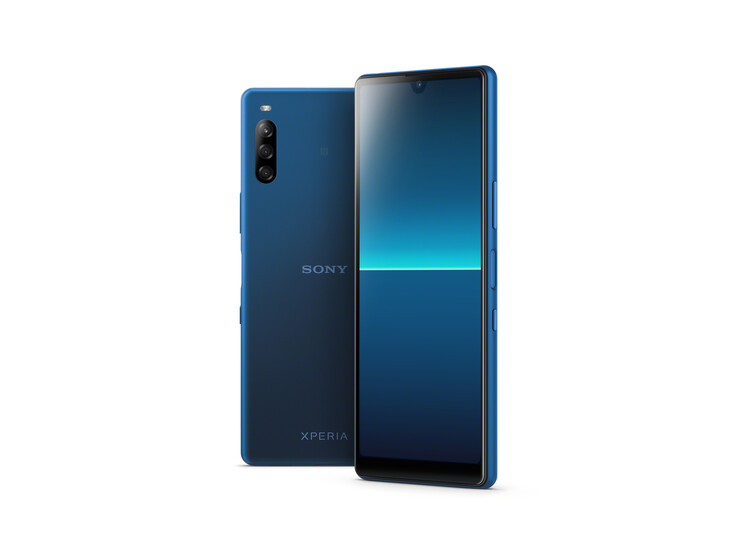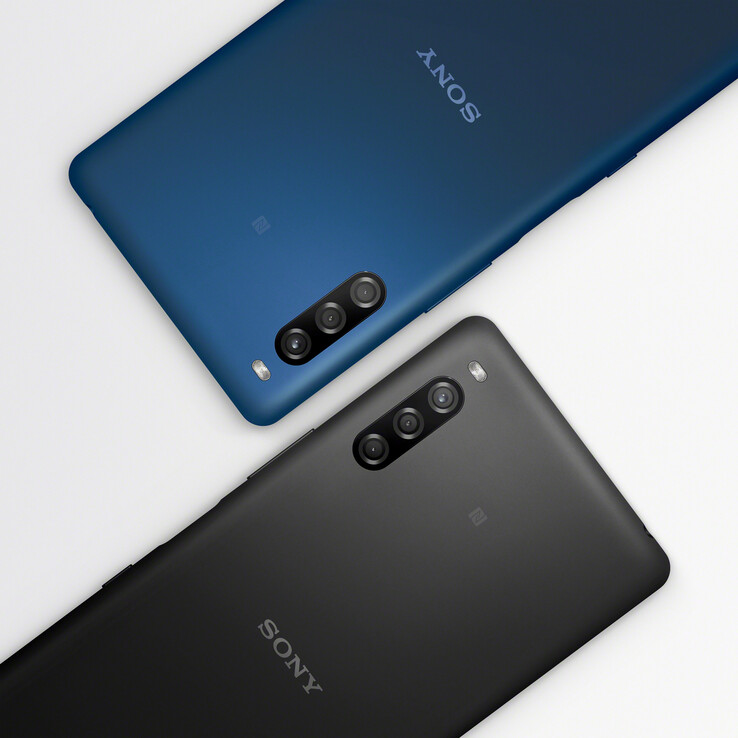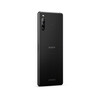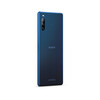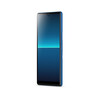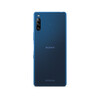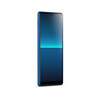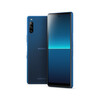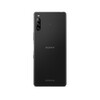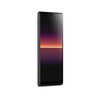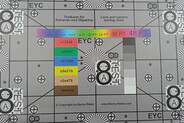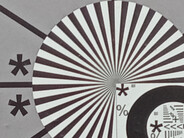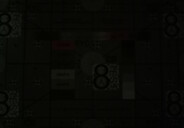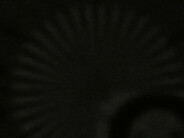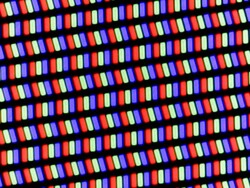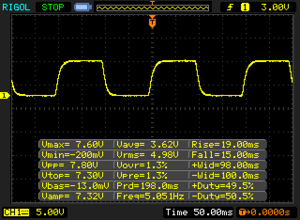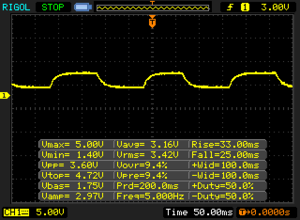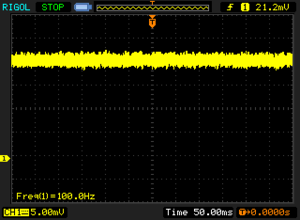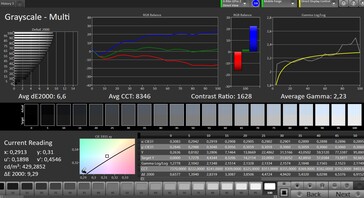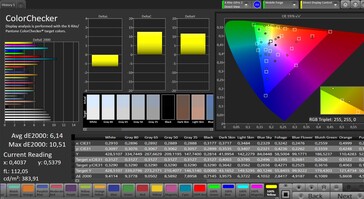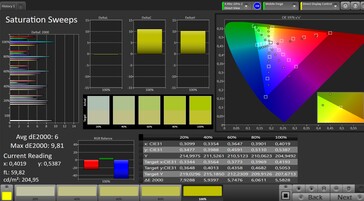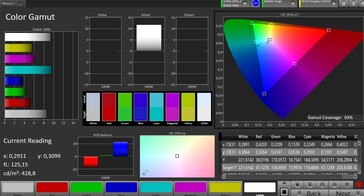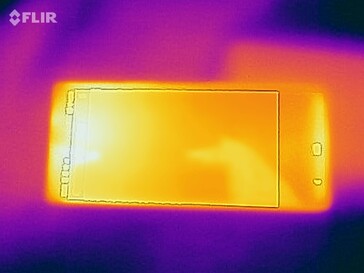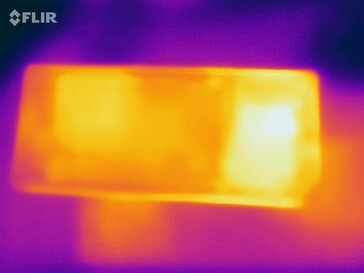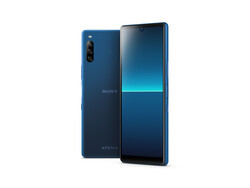Sony Xperia L4 smartphone Review - 2020 smartphone with 2018 android
Vergleichsgeräte
Bewertung | Rating Version | Datum | Modell | Gewicht | Laufwerk | Groesse | Aufloesung | Preis ab |
|---|---|---|---|---|---|---|---|---|
| 75.1 % v7 (old) | v7 (old) | 10 / 2020 | Sony Xperia L4 Helio P22 MT6762, PowerVR GE8320 | 178 g | 64 GB eMMC Flash | 6.20" | 1680x720 | |
| 78.2 % v7 (old) | v7 (old) | 06 / 2020 | Realme 6i Helio G80, Mali-G52 MP2 | 199 g | 128 GB eMMC Flash | 6.50" | 1600x720 | |
| 80.7 % v7 (old) | v7 (old) | 05 / 2020 | Xiaomi Redmi Note 9S SD 720G, Adreno 618 | 209 g | 128 GB UFS 2.0 Flash | 6.67" | 2400x1080 | |
| 76.6 % v7 (old) | v7 (old) | 05 / 2020 | Motorola Moto G8 SD 665, Adreno 610 | 188 g | 64 GB eMMC Flash | 6.40" | 1560x720 |
Case, equipment and operation - Chic and valuable
Sony can design, the Japanese have already proven this with dozens of Xperia phones. The Xperia L4 also feels valuable despite its plastic back and fits well in the hand thanks to its slim silhouette. The smartphone is somewhat sensitive to pressure, but otherwise makes a stable impression and is quite light at 178 grams.
Let's look at the inner values, we first trimmed: Android 9 on a device that will be released in 2020? Yes, Sony is taking this unusual step and at the time of testing there was no Andoid 10 update in sight. This means that the popular Dark Mode is missing, there is an option in the display settings for a dark design, but this only affects the App Drawer background. Also the security patches from May 2020 are already out of date at the time of testing.
The memory equipment includes the most necessary, but other manufacturers already offer 128 GB mass storage in this price range. For this purpose, there is NFC, which enables contactless payment with a cell phone.
The WLAN only comes with the rather slow WiFi 4 standard, but at least it achieves decent transfer rates in our test with the Netgear Nighthawk AX12.
| Networking | |
| iperf3 transmit AX12 | |
| Xiaomi Redmi Note 9S | |
| Sony Xperia L4 | |
| Realme 6i | |
| Motorola Moto G8 | |
| iperf3 receive AX12 | |
| Xiaomi Redmi Note 9S | |
| Sony Xperia L4 | |
| Motorola Moto G8 | |
| Realme 6i | |
Cameras - With wide angle camera, without macro
The Sony Xperia L4 comes with a 13-megapixel camera on the back, plus a wide-angle lens. However, a macro lens like on the comparable devices is missing. The camera takes surprisingly sharp pictures under normal lighting conditions, the colors are not very strong, but they look more realistic. In low light, the Xperia L4 only produces quite blurred photos that contain only a few details
The wide-angle lens is sufficient for snapshots, but the dynamics here are not very high, so bright and dark areas quickly lose their definition. Zooming between the two lenses is not possible in several steps, you can only switch directly.
Videos can be recorded in 1080p and 30 fps. The transition at different exposure situations is clearly visible here in quite coarse steps. The autofocus reacts fast on average, but pumps quite strongly before it finds the right setting.
On the front side there is an 8 megapixel camera, which is ok for selfies and also takes comparatively bright pictures.
Image comparison
Choose a scene and navigate within the first image. One click changes the position on touchscreens. One click on the zoomed-in image opens the original in a new window. The first image shows the scaled photograph of the test device.
Hauptobjektiv BlumeHauptobjektiv UmgebungHauptobjektiv Low LightUltraweitwinkel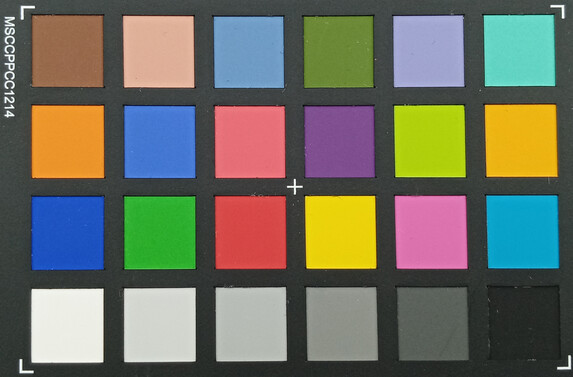
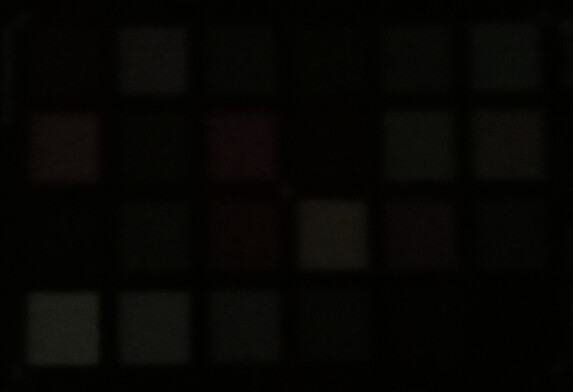
Display - No high brightness on the Xperia L4
The screen resolves with an extended 720p resolution, which is standard in this price class, but Xiaomi also shows that there is more to it than that with the Redmi Note 9S. The screen of the Xperia L4 is not very bright, even with the brightness sensor activated and fully exposed.
In our tests with the CalMAN software and the spectrophotometer, the Xperia L4 shows visible color deviations from the ideal value, even a blue cast is acceptable. PWM could be a problem for sensitive users at low brightness levels, so they should test the screen before buying.
| |||||||||||||||||||||||||
Brightness Distribution: 92 %
Center on Battery: 429 cd/m²
Contrast: 1650:1 (Black: 0.26 cd/m²)
ΔE ColorChecker Calman: 6.14 | ∀{0.5-29.43 Ø4.78}
ΔE Greyscale Calman: 6.6 | ∀{0.09-98 Ø5}
93% sRGB (Calman 2D)
Gamma: 2.23
CCT: 8346 K
| Sony Xperia L4 IPS, 1680x720, 6.2" | Realme 6i IPS, 1600x720, 6.5" | Xiaomi Redmi Note 9S IPS, 2400x1080, 6.7" | Motorola Moto G8 IPS, 1560x720, 6.4" | |
|---|---|---|---|---|
| Response Times | 25% | 27% | 20% | |
| Response Time Grey 50% / Grey 80% * (ms) | 58 ? | 50.4 ? 13% | 44 ? 24% | 46 ? 21% |
| Response Time Black / White * (ms) | 34 ? | 21.6 ? 36% | 24 ? 29% | 28 ? 18% |
| PWM Frequency (Hz) | 100 ? | 625 | ||
| Screen | 6% | 6% | 20% | |
| Brightness middle (cd/m²) | 429 | 518 21% | 622 45% | 504 17% |
| Brightness (cd/m²) | 404 | 484 20% | 612 51% | 452 12% |
| Brightness Distribution (%) | 92 | 89 -3% | 94 2% | 83 -10% |
| Black Level * (cd/m²) | 0.26 | 0.26 -0% | 0.56 -115% | 0.28 -8% |
| Contrast (:1) | 1650 | 1992 21% | 1111 -33% | 1800 9% |
| Colorchecker dE 2000 * | 6.14 | 5.8 6% | 3.98 35% | 3.84 37% |
| Colorchecker dE 2000 max. * | 10.51 | 11 -5% | 7.33 30% | 6.1 42% |
| Greyscale dE 2000 * | 6.6 | 7.3 -11% | 4.5 32% | 2.7 59% |
| Gamma | 2.23 99% | 2.23 99% | 2.206 100% | 2.235 98% |
| CCT | 8346 78% | 8037 81% | 7361 88% | 7125 91% |
| Color Space (Percent of sRGB) (%) | 114.9 | |||
| Total Average (Program / Settings) | 16% /
10% | 17% /
10% | 20% /
20% |
* ... smaller is better
Display Response Times
| ↔ Response Time Black to White | ||
|---|---|---|
| 34 ms ... rise ↗ and fall ↘ combined | ↗ 19 ms rise | |
| ↘ 15 ms fall | ||
| The screen shows slow response rates in our tests and will be unsatisfactory for gamers. In comparison, all tested devices range from 0.1 (minimum) to 240 (maximum) ms. » 90 % of all devices are better. This means that the measured response time is worse than the average of all tested devices (20.2 ms). | ||
| ↔ Response Time 50% Grey to 80% Grey | ||
| 58 ms ... rise ↗ and fall ↘ combined | ↗ 33 ms rise | |
| ↘ 25 ms fall | ||
| The screen shows slow response rates in our tests and will be unsatisfactory for gamers. In comparison, all tested devices range from 0.165 (minimum) to 636 (maximum) ms. » 94 % of all devices are better. This means that the measured response time is worse than the average of all tested devices (31.6 ms). | ||
Screen Flickering / PWM (Pulse-Width Modulation)
| Screen flickering / PWM detected | 100 Hz | ≤ 15 % brightness setting | |
The display backlight flickers at 100 Hz (worst case, e.g., utilizing PWM) Flickering detected at a brightness setting of 15 % and below. There should be no flickering or PWM above this brightness setting. The frequency of 100 Hz is very low, so the flickering may cause eyestrain and headaches after extended use. In comparison: 53 % of all tested devices do not use PWM to dim the display. If PWM was detected, an average of 8108 (minimum: 5 - maximum: 343500) Hz was measured. | |||
Performance, emissions and battery life - Low power
The Sony Xperia L4 is equipped with a MediaTek Helio P22, which makes it difficult for the smartphone to compete with other devices in its price range in terms of performance. With performance-intensive apps, volume control is only possible with a delay, but in everyday life you usually move through the system quite smoothly.
The memory is also significantly slower than on comparable devices. The Xiaomi Redmi Note 9S, for example, already offers UFS 2.1 memory for a similar price, leaving the Sony smartphone far behind.
The warming stays very within limits and is only slightly noticeable even under longer loads.
The mono loudspeaker on the lower edge is relatively quiet and doesn't sound very voluminous due to strongly sloping low mids. It gets better if you use external headphones or speakers, these can be connected via Bluetooth or 3.5mm audio port without any problems.
The battery life of the cheap Sony smartphone is OK with 13:03 hours, but the realme 6i offers almost 70% more runtime, but is also much heavier. For two days it should be enough with average everyday use. If the smartphone needs to be charged, the charger in the package does it with a maximum of 7.5 watts. If you want to use the quick-charging capability with a maximum of 18 watts, you have to purchase a quick-charger separately.
| PCMark for Android | |
| Work performance score (sort by value) | |
| Sony Xperia L4 | |
| Realme 6i | |
| Xiaomi Redmi Note 9S | |
| Motorola Moto G8 | |
| Average Mediatek Helio P22 MT6762 (4404 - 7465, n=18) | |
| Work 2.0 performance score (sort by value) | |
| Sony Xperia L4 | |
| Realme 6i | |
| Xiaomi Redmi Note 9S | |
| Motorola Moto G8 | |
| Average Mediatek Helio P22 MT6762 (3805 - 5380, n=21) | |
| GFXBench | |
| on screen Aztec Ruins Normal Tier Onscreen (sort by value) | |
| Sony Xperia L4 | |
| Realme 6i | |
| Xiaomi Redmi Note 9S | |
| Motorola Moto G8 | |
| Average Mediatek Helio P22 MT6762 (6.4 - 7.6, n=21) | |
| Average of class Smartphone (6.2 - 166, n=209, last 2 years) | |
| 1920x1080 Aztec Ruins Normal Tier Offscreen (sort by value) | |
| Sony Xperia L4 | |
| Realme 6i | |
| Motorola Moto G8 | |
| Average Mediatek Helio P22 MT6762 (3.5 - 4.7, n=21) | |
| Average of class Smartphone (3.4 - 367, n=209, last 2 years) | |
| on screen Aztec Ruins High Tier Onscreen (sort by value) | |
| Sony Xperia L4 | |
| Realme 6i | |
| Xiaomi Redmi Note 9S | |
| Motorola Moto G8 | |
| Average Mediatek Helio P22 MT6762 (4.1 - 4.8, n=21) | |
| Average of class Smartphone (0.85 - 144, n=210, last 2 years) | |
| 2560x1440 Aztec Ruins High Tier Offscreen (sort by value) | |
| Sony Xperia L4 | |
| Realme 6i | |
| Xiaomi Redmi Note 9S | |
| Motorola Moto G8 | |
| Average Mediatek Helio P22 MT6762 (1.3 - 1.6, n=21) | |
| Average of class Smartphone (1.2 - 146, n=209, last 2 years) | |
| Sony Xperia L4 | Realme 6i | Xiaomi Redmi Note 9S | Motorola Moto G8 | Average 64 GB eMMC Flash | Average of class Smartphone | |
|---|---|---|---|---|---|---|
| AndroBench 3-5 | 109% | 108% | 79% | 6% | 868% | |
| Sequential Read 256KB (MB/s) | 293.4 | 309.5 5% | 496.6 69% | 301 3% | 277 ? -6% | 2228 ? 659% |
| Sequential Write 256KB (MB/s) | 165 | 256.4 55% | 214.8 30% | 239 45% | 178.4 ? 8% | 1852 ? 1022% |
| Random Read 4KB (MB/s) | 61.2 | 73.5 20% | 137 124% | 57.3 -6% | 60.7 ? -1% | 296 ? 384% |
| Random Write 4KB (MB/s) | 22.5 | 150.9 571% | 123.6 449% | 128.1 469% | 33.8 ? 50% | 339 ? 1407% |
| Sequential Read 256KB SDCard (MB/s) | 83.5 ? | 84.6 ? 1% | 74.5 ? -11% | 68.7 ? -18% | 77.4 ? -7% | |
| Sequential Write 256KB SDCard (MB/s) | 62.5 ? | 64.5 ? 3% | 54.9 ? -12% | 48.7 ? -22% | 58.3 ? -7% |
Temperature
(±) The maximum temperature on the upper side is 41.1 °C / 106 F, compared to the average of 35.2 °C / 95 F, ranging from 21.9 to 247 °C for the class Smartphone.
(±) The bottom heats up to a maximum of 40 °C / 104 F, compared to the average of 34 °C / 93 F
(+) In idle usage, the average temperature for the upper side is 31 °C / 88 F, compared to the device average of 32.9 °C / 91 F.
Speakers
Sony Xperia L4 audio analysis
(±) | speaker loudness is average but good (75.6 dB)
Bass 100 - 315 Hz
(-) | nearly no bass - on average 29.7% lower than median
(±) | linearity of bass is average (8.9% delta to prev. frequency)
Mids 400 - 2000 Hz
(±) | higher mids - on average 6.9% higher than median
(±) | linearity of mids is average (9.6% delta to prev. frequency)
Highs 2 - 16 kHz
(+) | balanced highs - only 2.4% away from median
(+) | highs are linear (4.2% delta to prev. frequency)
Overall 100 - 16.000 Hz
(±) | linearity of overall sound is average (29.8% difference to median)
Compared to same class
» 77% of all tested devices in this class were better, 4% similar, 19% worse
» The best had a delta of 11%, average was 35%, worst was 134%
Compared to all devices tested
» 88% of all tested devices were better, 3% similar, 10% worse
» The best had a delta of 4%, average was 24%, worst was 134%
Xiaomi Redmi Note 9S audio analysis
(±) | speaker loudness is average but good (81 dB)
Bass 100 - 315 Hz
(-) | nearly no bass - on average 64.7% lower than median
(+) | bass is linear (0% delta to prev. frequency)
Mids 400 - 2000 Hz
(-) | nearly no mids - on average 64.7% lower than median
(+) | mids are linear (0% delta to prev. frequency)
Highs 2 - 16 kHz
(-) | nearly no highs - on average 64.7% lower than median
(+) | highs are linear (0% delta to prev. frequency)
Overall 100 - 16.000 Hz
(-) | overall sound is not linear (119.7% difference to median)
Compared to same class
» 88% of all tested devices in this class were better, 8% similar, 3% worse
» The best had a delta of 11%, average was 35%, worst was 134%
Compared to all devices tested
» 97% of all tested devices were better, 3% similar, 1% worse
» The best had a delta of 4%, average was 24%, worst was 134%
Battery life
| Sony Xperia L4 3580 mAh | Realme 6i 5000 mAh | Xiaomi Redmi Note 9S 5020 mAh | Motorola Moto G8 4000 mAh | Average of class Smartphone | |
|---|---|---|---|---|---|
| Battery Runtime | |||||
| WiFi Websurfing (h) | 13.1 | 22 68% | 19.8 51% | 16.5 26% | 19.3 ? 47% |
Pros
Cons
Verdict - Good looks alone are not enough
The Xperia L4 is understated, but very chicly designed and looks more expensive than it is. Unfortunately this doesn't help much if the inner values leave a lot to be desired: The software is outdated, as are the security patches. The screen is not bright enough and has a strong blue cast.
On the credit side, there are the neat sounding loudspeakers, the somewhat faster WLAN than with some comparable devices and the possibility to recharge the cell phone quickly if you buy an appropriate charger. The camera also takes decent pictures and is quite flexible with its many lenses.
However, the competition is strong in this environment and the Sony Xperia L4 is definitely not the price-performance winner in this class.
The Sony Xperia L4 convinces with its looks, but leaves some feathers in its cap due to outdated software.
If you have fallen in love with the appearance of the smartphone and are wondering if you can get a solid phone for your money, let me tell you: If the price drops, you can definitely take a look at the smartphone. However, up-to-date software and long battery life should then not play too big a role.
Sony Xperia L4
- 08/13/2020 v7 (old)
Florian Schmitt




